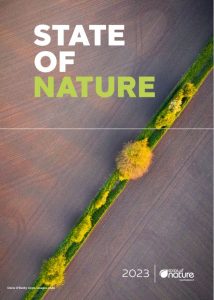The State of Nature report is a massive document (108pp) profusely illustrated in colour (mostly RSPB images) with numerous graphs (mostly showing downwards trends), and covering what is happening in the UK as well as the Overseas Territories (OT) and Crown Dependencies (CD). Sixty-six government bodies and NGOs supplied information.
There are plenty of references to key works that present the accumulated evidence. The trajectory of the state of nature is definitely downwards, and the 280 references to ‘decline’ is testament to that. In contrast it was surprising that the concepts of ‘natural capital’ and net loss and net gains are hardly mentioned. It is perhaps early days to expect any of the mitigation that supports the net gain initiatives that will go live in January 2024 to buck the downward trend, are mentioned.
The review assesses the ‘major pressures on the UK’s nature over the past 50 years.’ What has driven the declines is down to ‘ , significant and ongoing changes in the way we manage our land for agriculture, and the effects of climate change, are having the biggest impacts on our wildlife.’
Knowing that a dozen SSSIs have been impacted to make way for the HS2 railway, I looked for reference to this, and accompanying mitigation to see how the net loss and net gain had been calculated, but there is no mention, and no mention of impacts from infrastructure, railways and roads per se. The nearest reference is under ‘pressures and responses’, but the SSSIs comments are wrapped up in a graph showing that about 40% of SSSIs are favourable across the four countries, leaving ‘unfavourable’ or ‘unknown’ statements for most. Not a good record.
This is what the authors said about various groups.
Flora & Bryophytes: ‘Since 1970, the distributions of 54% of flowering plant species and 59% of bryophytes (mosses and liverworts) have decreased across Great Britain’
Lichens: ‘Strong decreases in plant and lichen distributions. Since 1970, the distributions of 47% of flowering plants, 62% of bryophytes (mosses and liverworts) and 57% of lichens have decreased, compared to 27, 25 and 34% of flowering plants, bryophytes and lichens respectively, that have increased in distribution.
Invertebrates:
- Across 4,979 invertebrate species, there was an average decrease in species’ distributions of 13% between 1970 and 2020
- Distributions of 2,149 invertebrates increased by 15% on average since 1970. This was driven by climate change and large average increases in the distributions of aquatic insects
- Pollinating insects (bees, hoverflies and moths), which play a critical role in food production, show an average decrease in distribution of 18%
- Average 15% decline in species’ abundance, for 407 terrestrial and freshwater species, abundance across Scotland has fallen by 15%, on average, since 1994
- Of the 62 species assessed in the 2010 and 2021 butterfly Red Lists, 11 species became more threatened and five became less threatened.
- Average 15% increase in the distributions of invertebrate species.
11% of species are threatened, of 7,508 species in Scotland that have been assessed using IUCN Red List criteria, 11% have been classified as threatened with extinction from Great Britain
It is worth noting, separately, that Buglife-The Invertebrate Conservation Trust, state in a flier received Nov 2023 that ‘today ..for every four insects around 20 years ago there is just one.
Birds: The abundance of 11 seabird species in Scotland has fallen by 49% on average since 1986. These results pre-date the current outbreak of Highly Pathogenic Avian Influenza’ There is nothing on swifts, house martins and swallow which are all know to be in decline.
Mammals: Between 1970 and 2016 the distribution of small mammals (mice, voles and shrews) decreased on average by -29%, those of mid-sized mammals (eg mustelids and hares) showed a similar but not significant change of -15%’
Amphibians and reptiles: there was not a lot on these herps, more information on them in the Overseas Territories and Dependencies.
So, overall the state of UK’s nature is not so good!
